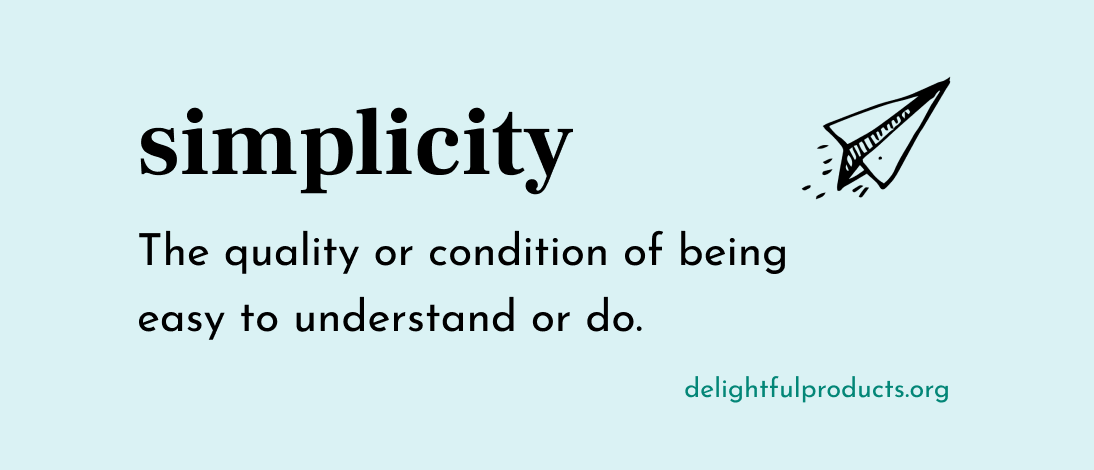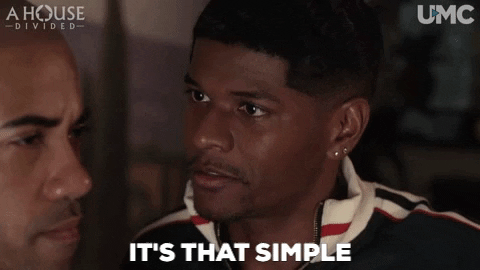Issue 8: Simplicity
Delightful Products is a monthly newsletter exploring product design and delight. For future updates, subscribe here.
In this Issue 👀
To navigate, click the linked sections below or simply scroll 📜
A short, 1-min overview of simplicity.
A 3-step guide to simplifying your products.
3 handy resources to learn about simplicity.
A Simple Truth
““Life is really simple, but we insist on making it complicated.”
”
Welcome to the 8th issue of Delightful Products! 😱 First off— an apology: these issues have been getting super long! Starting today, I'm committing to giving you the same great content, but in 1000 words or less.
Which brings us to this month's topic: simplicity! Good design is simple. What do we mean by simple?
Simple = ease. It's easy to understand, easy to learn, easy to operate. In short, simple things just make sense.
In behavioral design, simplicity theory states that people prefer products and experiences with less complexity. But then… why do we have so many products that are overstuffed and hard to use? 🤔
Answer: Most product teams aren’t focused on simplifying. We're urged to do the opposite, adding new features and improvements as often as we can. This inevitably leads to products that are clunky and complicated.
How do we avoid this? Read on to find out!
3 Steps to Simple Products
To keep your products simple, all you need are 3 steps: prioritize, organize, and reduce.
#1: Prioritize 🌟
Products become complicated when we're trying to optimize for too many things at once. To simplify, you need to prioritize: stay laser-focused on user goals and cut out everything that's not needed. Ask yourself:
Why are they coming to you in this moment? (Because they're bored)
What do they need done? (To find entertainment)
What is the minimum number of steps they can take in your product to solve their problem? (Ideally, get this down to 1-2 steps)
In a study on attention span & video content, researchers found that mobile users spend about 1.7 seconds per piece of video content. Fast forward to today, video-centric apps (TikTok, Netflix, Twitch) all immediately start playing video the moment the page loads. Not only that, their algorithms are incredibly skilled at predicting what you might want to see next.
The result? A simple product that quickly prioritizes and satisfies your needs, over and over again.
#2: Organize 🗂️
““Life truly begins after you have put your house in order.”
”
Gestalt theory is the idea that our brains are always trying to make sense of the world by simplifying and grouping things together. We are very good at recognizing patterns and we love when things are organized in ways that make sense. 🧠
⤷ Above: Puzzles are a great example of Gestalt theory in action.
To simplify your product, you need to organize the content and user interface. Here's how:
Group things that are similar: For content, that means similar topics should go together. For UI, that means related components should sit close to one another, so they feel like a single group.
Use color and shapes consistently: In UI, we expect things that look alike to act the same. If a yellow "Next" button always goes to another page, don't suddenly open a popup window. Use colors to imply functionality. For more on this, read our "Color" issue.
#3: Reduce 🔽
““The more you love yourself, the less nonsense you’ll tolerate.”
”
The last step to simple products: reduce the amount of information and steps you present at a time. Here's how:
Use smart defaults: Help people along by pre-selecting options or auto-filling fields, so they don't have to. Many online stores will ask if you want to save your credit card info, so that it's a simpler shopping experience for next time. 🛒
Limit options: Don't give people 10 different choices, when they only want 3. One way to narrow down options is by going back to step 2, organizing them into larger groups.
Use progressive disclosure: Instead of overwhelming people with too much all at once, defer advanced content and features for later on. If you're buying airplane tickets, for example, most sites ask where you're going on one page. As you progress, you then unlock additional choices like paying with dollars or points, or bundling with hotels.
More illustrations; less text: In products, illustrations can be incredibly helpful to show people what to do, and much simpler than writing it all out. For more, check out our previous issue.
Learning Resources
Intrigued by simplicity? Here are a few fascinating ways to learn more:
For UX designers: learn more about simplicity theory in this article by UXMag.
For managers & leaders: wonder if you or your team are overcomplicating things? Read this simple checklist of 8 behaviors that contribute to everyday complexity.
For systems thinkers: Ecologist Eric Berlow studies complex systems in nature. His 3-minute Ted Talk, "Simplifying complexity", illustrates his tips & tricks for making complicated systems easier to understand.
Wrapping Up 🎁
““Perfection is achieved not when there is nothing more to add, but when there is nothing left to take away.”
”
Simple products are straightforward, uncomplicated, and easy to learn. They give people a clear and direct path to reach their goals. They remove steps and minimize time and cognitive load. And best of all, they’re inclusive— working easily for anyone, no matter who they are.
Next time you get ready to design a product, or release a new feature, ask yourself first: how can I make this more simple?
And don’t forget: prioritize, organize, and reduce.
Liked this issue? Please share & subscribe 💞
Share: Send this issue to your favorite people or send some hype on Twitter!
Subscribe: Join 130+ product lovers and subscribe to get new issues straight to your inbox.
About the Writer
Lucy is a product leader, design nerd, and occasional blanket burrito. When not putting together newsletters, you can find her nose deep in a book or decorating the sh!t out of her apartment.
If you’re curious about digital products, lifelong learning, or creating flow, let’s connect on Twitter!




